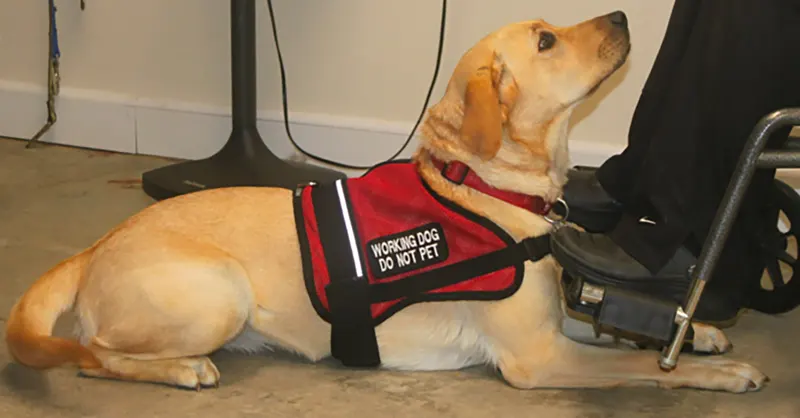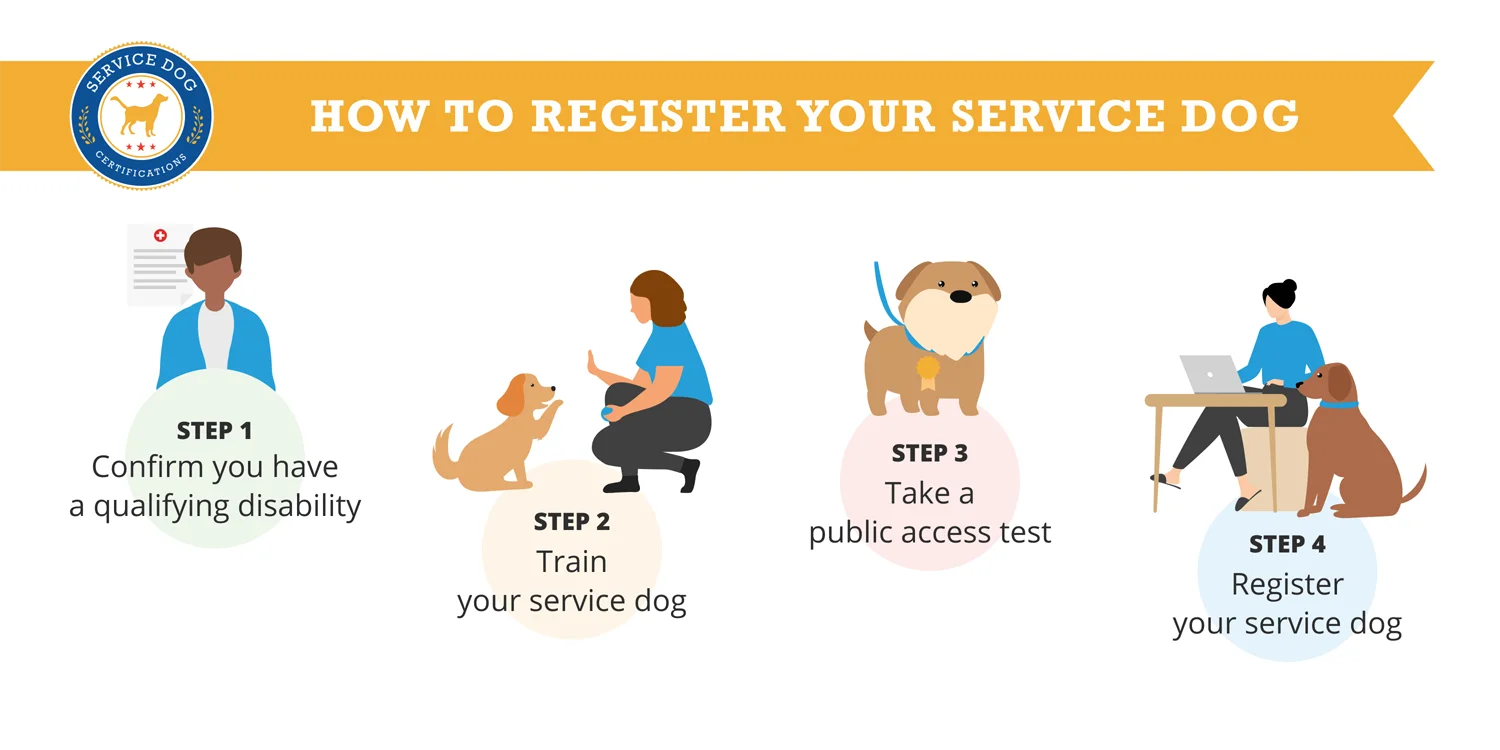Home Page › Blog › Service Dog Requirements
Service Dog Requirements

The ADA defines a Service Animal as a dog individually trained to perform tasks or do work for the benefit of a person with a disability. A disability can be a physical impairment, but the ADA also includes mental illnesses that substantially limit one or more major life activities, such as depression, severe anxiety, or PTSD.
This article will cover the qualification requirements to be a Service Dog handler, what training and tests can be expected for your Service Dog, and what to expect when in public. After covering the legal rights of Service Dogs, we’ll present options for facilitating interactions with the public, including specialized Service Dog accessories and identification.
What are the Service Dog requirements?
Training a dog to become a service animal is available to individuals who have a disability. If you are interested in having a service dog, below are requirements to be aware of:
Eligibility: A person is eligible for a service dog if they have a physical, emotional, or mental health disability
Training: The dog must be trained to take a specific action when needed to assist the person with a disability. The task(s) performed by the dog must be directly related to the person’s disability. The ADA does not require professional training; people with disabilities have a right to train the dog themselves.
Behavior: A service dog must be under its handler’s control at all times.
Verification: If it is not obvious what service the dog provides, the handler must be willing to answer two questions about their service dog. These two questions are: (1) is the dog a service animal required because of a disability? and (2) what work or task has the dog been trained to perform? Staff are not allowed to request any documentation for the dog, require that the dog demonstrate its task, or inquire about the nature of the person’s disability.
Identification: Optionally, it can help service dogs to be clearly identified with accessories like ID cards, vests, tags, and certificates.
How does my dog become a Service Dog?
Consider these four simple steps to help you understand how your dog can become a service dog.
- Determine if you have an eligible disability
- Train your Service Dog
- Pass a Public Access Test
- Consider Service Dog Certification and Registration
Service Dogs serve an important function for those in our community who need special care. It’s crucial for both Service Dog handlers and the general public to be aware of what Service Dog requirements are.
Step 1: Determine if you have an eligible disability
Under the ADA, you must have a qualifying condition to have a Service Dog. The condition can take many forms (physical, mental, etc.). Physical disabilities include conditions like visual impairment, limited mobility, and hearing loss. The physical or mental impairment must substantially limit a major life activity like the ability to work, move about, socialize, or sleep.
Some common conditions that qualify for Psychiatric Service Dogs are anxiety, depression, and PTSD, but this list is not exhaustive. For psychiatric disabilities, a common first step is to be evaluated by a Licensed Mental Healthcare Practitioner (LMHP) who can write a letter confirming your eligibility. These PSD letters typically have the following traits:
- written on the licensed healthcare professional’s letterhead
- dated and signed by the professional
- contain the professional’s contact information, license number, license date, and state of licensure
- contain the professional’s opinion on whether you have a mental or emotional disability that can qualify for a psychiatric service dog
Step 2: Training your Service Dog
To be considered a Service Dog, a dog must be individually trained to perform a job or task relating to your disability. Be aware that there is no official organization that sets training standards in the U.S. You are not required to work with a trainer – the ADA allows handlers to train their dogs on their own.
While there’s no minimum requirement in the US, some private standards suggest approximately 120 hours over six months. Some sources recommend that at least 30 hours (about ¼ of the time) be spent in public to help train the dog for moments of distraction and when surprises come their way. While not required, it can be helpful for Service Dogs to wear relevant accessories so that people in public can adjust their behavior accordingly.
The most important thing for you to teach your Service Dog is tasking or learning the specific skill they will be performing to help assist with your disability. There are countless tasks Service Dogs are called on to perform, including guiding the visually impaired, pulling a wheelchair, sensing a medical alert, tactile stimulation during a panic attack, reminding the handler to take their medication, scouting a room for someone with PTSD, or grounding/blocking in public areas.
Step 3: Pass a public access test
In addition to training your dog to perform tasks that assist with your disability, it is important for a service dog to be able to comport itself appropriately in public by passing a public access test.
Public Access Criteria:
- No aggressive behavior towards people and other animals.
- Refrain from sniffing behaviors unless released to do so.
- No solicitations for food or affection while on duty.
- No over-excitement and hyperactivity in public.
- Able to tolerate novel sights and sounds in various public settings.
- No unruly behavior or excessive barking.
- No relieving themselves in public without being given a specific command.
Once your dog is properly trained, your next step is to decide how you prefer to identify your service dog.
Step 4: Service Dog Certification and Registration
In the United States, service dog certifications and service dog identifications are not legally required. Staff at a public establishment cannot solicit documentation, such as proof that the animal has been certified, trained, or licensed as a Service Dog, as a condition for entry.
Despite the limited verification requirements established by the law, staff at many public establishments will still insist on IDs or other tangible proof of Service Dog status. Service Dog handlers often find it helpful to have documents and accessories that help signal that their dog is trained and at work in order to prevent being met with hostility and confusion.
Electing to carry a custom Service Dog ID card and Service Dog Vest may be helpful tools for you and your service dog to navigate public spaces. You may also choose not to carry the ID card and stand your ground on principle when you encounter people ignorant of service dog rights. Under ADA rules, staff at a venue may only ask two questions if the handler’s disability is not apparent: (1) is the dog a service animal required because of a disability? and (2) what work or task has the dog been trained to perform?

After you verbally confirm that your dog is a trained service dog, reasonable accommodations must legally be made for service dogs. Service Dogs can go anywhere their handlers can go, provided they do not pose a health or safety hazard to others. If a particular service animal behaves in a way that poses a direct threat to the health or safety of others, has a history of such behavior, or is not under the control of the handler, that animal may be excluded. If an animal is excluded for such reasons, staff must still offer their goods or services to the person without the animal present. It’s important to understand these rules so you know what rights you have as the owner of a Service Dog and when third parties are violating your rights.
You’re all caught up on what it takes to have a Service Dog!
Ready to register and ID your dog?
Unable to train your dog as a service dog?
You may be interested in an Emotional Support Animal instead. ESAs do not require specific training, have access to no-pet apartments, and are exempt from breed or weight restrictions. Click here to learn more about ESAs.
In short, ESAs are protected under Federal Housing Regulations (but not the ADA), meaning that you cannot be charged any pet rent, deposits, or fees, nor can you or your ESA be denied housing on the grounds of living with a pet, with very few exceptions.
To qualify for an ESA, you must have a licensed mental health practitioner (including, but not limited to, psychologists, therapists, social workers, GPs/PCPs, etc.) write a letter affirming that you have a qualifying condition (including, but not limited to, depression, anxiety, PTSD, etc.) that is helped by an emotional support animal. Additionally, unlike Service Animals, ESAs do not necessarily have to be dogs; cats, rabbits, and birds are other common choices.
¿Quieres leer este artículo en español?
Puede encontrar una versión traducida al español de los requisitos para perros de servicio aquí.
Want to read this article in Spanish?
You can find a Spanish translated version of Service Dog Requirements here.
About the Author: The writing team at Service Dog Certifications is made up of folks who really know their stuff when it comes to disability laws and assistance animals. Many of our writers and editors have service dogs themselves and share insights from their own experiences. All of us have a passion for disability rights and animals.
439 comments
Leave a Reply Cancel reply
Latest Posts

How to Bring a Service Dog to Disneyland
Trained service dogs are more than welcome to join their handlers at Disneyland. In this guide, we’ll explain Disneyland’s policies and give practical advice for bringing a service dog to Disneyland for the first time. Disneyland’s Service Dog Policies The Magic Kingdom is happy to welcome trained service dogs across most park locations! They kindly […]

Read More

Can Dogs Eat Tomatoes?
Yes! Dogs can safely enjoy tomatoes, but there are a few risks to be aware of so you can feed your dog responsibly. Fully ripe tomatoes (without the stems and leaves) can actually have nutrients that are good for your pup. Tomatoes have chlorogenic acid, an antioxidant that can have anti-inflammatory effects in cells. They’re […]

Read More

Can a Primary Care Doctor Write an ESA Letter?
Your family doctor, also called a primary care physician (PCP), can write a letter recommending an emotional support animal. We’ll explain what legally gives them that ability and explore what better options might be available for you. Why are Physicians Able to Write an ESA Letter? To turn your pet into an emotional support animal, […]

Read More







Hi, I suffer from depression and was wondering about an emotional support dog. Is there a form my doctor needs to fill out in order for the process to begin by getting a dog?
To get an ESA you need a mental health specialist to give you a doctors note.
Me and my fiance have a service dog in training. Can a renter deny her just because shes still in training?
If a renter denies, that’s considered breaking the law. Although, you may want to get a doctors note until your dog is fully trained.
I would like to start the process of working with my son as the handler to train our dog as a service dog we can get a letter from his dr no problems as he is in a wheelchair and would benefit greatly from the help of a service dog. I would like to find out how we go about it legally. Thank you in advance for your help
Look Into your state’s laws and regulations each state is different in the SDIT. You could claim her as an ESA until she is fully trained, Due to the Fair housing act and ADA renters cannot deny ESA’S.
Not if you provide documentation stated that you need her
I have a lab/pit 7 months old. I was born with club feet. My puppy is very intelligent and picks up things really fast. Is there anyone out there that could point me in the right direction on finding a good trainer in my area?? I’m from mount pleasant, Mi.
I have a gentle american Staffordshire Terrier. He has been wilh us since we foung him in crown point. Approximately 6 moth old. I swear he can hear everythinh we say but he cant sayanthing bach to. I must be verry frustrating. I eant to get him certified so he can go into stores with Austin.
Austin is emotionally disabled and he and I boyh feel he would beiffit for a emotional support dog. If you send and info you may have.
Emotional Support Dogs (ESA) are different than Service Dogs (SD). An ESA only provides comfort to you in your home, they do not have public access rights, but they do quality for the Fair Housing Act which allows them to live with you anywhere whether the place you live has a no dog policy or breed restriction policy or not. A Service Dog (SD) is a trained dog that can do one or more tasks that help you out with your disability. Examples of SD tasks: alerting (by pawing, nosing, licking) the person when they are having a panic attack or anxiety attack; persistently pawing at, barking at and or taking away a sharp object from a person who is doing self harm; picking up dropped objects for someone either in a wheelchair or who’s disability makes it hard for them to bend or pick things up themselves; hearing a timer go off which they are trained to respond to by bringing a person their medication. Those are just a sample few things that dogs can be taught to help their disabled owners in their day to day life that they can’t easily do themselves. An SD has full public access rights to go with a person no matter where they are going, be it a shopping mall, store or even restaurant. The only exceptions to that are privately owned places of worship, or some schools.
Sorry i mean CGC (canine good citizen test)
My Husband has had two major back surgeries which has left him with debilitating muscle spasms which cause him to fall or drop, chronic pain, cannot straighten up, and has a difficult time try to look up at people when he is talking to them. If he sits to long, he has a very difficult time standing up and usually needs someone to help him walk if he is able to at all at that time. Our shiz-tzu- Chin alerts and barks when he has these attacks or falls and helps keep my husbands panic levels down. Does this qualify as a service dog?
I have endometriosis and ovarian cysts…I have very hard days and sometimes cannot even get out of bed. and days that I am very weak and have fainting spells…Would I cover for a service dog or just a therapy dog
Yes, you qualify for a service dog. If any, you would probably need a Medical Alert service animal.
I also have severe endometriosis and ovarian cysts, along with a bladder disease. I’ve had three surgeries this year, and it has left me drained and weak. Some days are extremely hard and my dog is the only reason I can get out of bed on those days. He’s still a puppy (7 months) but he’s very intuitive and he detected cancer in his breeder by pawing/digging at the site of the cancer. He helps me when I’m in pain, and calms me down when I have panic attacks or mood swings. I’m still in college, I struggle to get through the day without him so I would like to be able to bring him with me to campus and in public but so far he’s only an emotional support animal and they’re not allowed in public places. An ESA only needs a letter from a doctor stating you have medical need for an animal and is allowed in any housing, and cannot be denied by a landlord or it is discrimination against a disabled person. A service animal must be trained to perform at least one task specific to your disability although there is no formal test. If you have fainting spells and have a larger breed dog you could train it to protect your head when falling and many people have done this. If you can train them to bark or notify someone when you are ill or unconscious, that works as well. I believe you can even teach them to put pressure on your body in certain places to alleviate pain, or to comfort you with touch when you’re having an episode. I know how hard this disease is to live with, and you shouldn’t have to. I got my dog three months ago and my world is so different, he’s offered me the support I’ve needed in this dark place. You definitely qualify for an emotional support animal just ask your doctor for a letter and tell them you wouldn’t be able to get out of bed and take care of yourself sometimes without your dog, and if you can train them to perform a task/be well behaved you can make them a service dog. I hope you find some comfort throughout this difficult journey and really hope you find a sweet dog to keep you company.
I also suffer from endometriosis and ovarian cysts, as well as a painful bladder disease. I’ve had three surgeries this year and it has left me feeling drained and weak, and I’m still in a great deal of pain most of the time. I’m still in college and it’s hard to get through the day, but my dog has changed everything. I still deal with considerable issues and pain, but he makes it so much easier to handle and there are many days I wouldn’t be able to get out of bed and care for myself if it wasn’t for him. My doctor gave me a letter making him an emotional support animal, so I’m not allowed to be denied housing by anyone or charged for him or it’s discrimination against a disabled persons. He helps me when I’m in pain, and calms me down when I have bad anxiety or mood swings so I would like to be able to take him with me to school and in public to help me throughout the day. Emotional support animals are not allowed in public places, though, just aircrafts. Service dogs are only required to perform one task specific to the person’s disability. You definitely qualify for an ESA just ask your doctor for a letter and they should be willing to write one, if not explain that there are days when you truly cannot care for yourself and get up out of bed if it weren’t for your dog. You probably qualify for a service dog as long as you can train it/make sure it is well behaved. For your specific condition, if you have fainting spells (which are extremely serious and dangerous) it is possible to train a larger breed dog to protect your head in a fall. If not, train your dog to help protect you as best as they can in that event and notify someone that you’re hurt by barking or finding someone. If you struggle with emotional issues either due to a condition or because of your physical state, you can train your dog to apply pressure to certain areas of your body if you need it, or you can train them to comfort you with touch by hugging you, sitting in your lap or beside you, and/or rubbing your back to keep you calm. I truly hope you find some comfort on this rough journey, and I very sincerely hope you get a dog whether it is trained or not. I got Wally three months ago and I don’t know how I made it through the day before that. Good luck!
It’s completely up to your medical specialist, but it sounds like you most likely qualify for medical alert.
Hello. I’m mainly interested in getting my dog licensed how to do that. I have promision from my dr that my dog is a service dog but I’m just learning that I will need her lisenced.